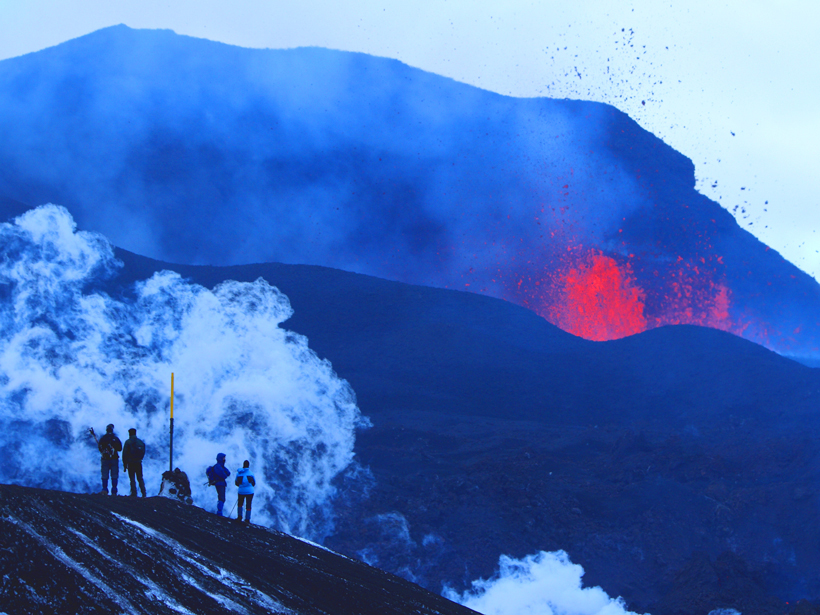Volcanoes are among the most dramatic landscapes on Earth and often are popular tourist destinations. A just-launched commission of a volcanology association wants to highlight the scientific and educational value of such landscapes and help protect them as a geological heritage.
The Commission on Volcano Geoheritage and Protected Volcanic Landscapes (VGPL), which launched on 29 June during a special session at the International Union of Geodesy and Geophysics (IUGG) general assembly in Prague, Czech Republic, has some big objectives. Among them are to identify the scientific value of protected volcano areas and to contribute scientific knowledge to managing these areas.
The commission, a new initiative of the International Association of Volcanology and Chemistry of the Earth’s Interior (IAVCEI), also aims to communicate the values of geological heritage through education and interpretation and emphasize volcano geotourism for economic and community sustainable development. IAVCEI is a semiautonomous association of IUGG.
The Impetus to Protect and Manage Volcanic Regions
The commission plans to work with the United Nations Education, Scientific and Cultural Organization (UNESCO) World Heritage Committee and other bodies to protect volcanic regions. Several VGPL commission leaders spoke with Eos about the timely need for the new organization.
Increased geotourism, particularly to volcanic landscapes and active volcanoes, makes us “consider these volcanic landscapes and volcanic regions as critical areas to protect and conserve.”
Increased geotourism, particularly to volcanic landscapes and active volcanoes, makes us “consider these volcanic landscapes and volcanic regions as critical areas to protect and conserve,” Joan Martí, secretary general of IAVCEI, told Eos. The sites are important to the world’s natural heritage because of the “unique geoscientific aspects they represent” and because they serve as “places to enjoy and learn about the science and history of our planet,” he added.
“To contribute to this conservation, it is necessary to increase the scientific knowledge” about these volcanic landscapes as well as to “guarantee the security of their visitors by conducting accurate hazard assessments,” Martí continued.
The IAVCEI executive committee approved the VGPL commission last November, explained Martí, a professor of research at the National Research Council of Spain (CSIS) and coordinator of CSIS’s Group of Volcanology of Barcelona.
A Knowledge Hub
VGPL commission co-leader Karoly Nemeth, senior lecturer at the Institute of Agriculture and Environment at Massey University, New Zealand, emphasized the need to properly communicate volcano science.
The commission could act as a “knowledge hub” and provide quality control for “the design of scientifically correct geoconservation, geoeducation, and geotouristic programs,” he suggested. The commission also could help ensure stronger IAVCEI representation in various geoprotection programs, he added.
International Programs to Protect Geoheritage Sites
In a presentation during the IUGG special session, commission co-leader Thomas Casadevall, scientist emeritus with the U.S. Geological Survey, focused on international programs to protect geoheritage sites. Casadevall said that, while there are more than 1000 UNESCO World Heritage sites, the majority are designated as cultural sites. Of the approximately 200 designated natural sites, about 17 are volcano sites, although some culturally designated sites, including Mount Fuji in Japan, have a strong volcanic focus.
Casadevall urged scientists to use their expertise to help protect volcanic geoheritage areas.
He urged scientists to use their expertise to help protect volcanic geoheritage areas. Casadevall specifically suggested that scientists could volunteer to evaluate World Heritage site nominations; attend the 2nd Volcandpark Conference in the Canary Islands, Spain, in November, for which IAVCEI is a sponsor; and assist with the revision of a global review of volcanic World Heritage properties.
Just visiting a volcanic property designated a World Heritage site, a geopark, or a biosphere reserve would be a way for scientists to become involved in the issue. Those sites, he said, “generally are that country’s proudest expression of its Earth science heritage.”
—Randy Showstack, Staff Writer
Citation: Showstack, R. (2015), New commission aims to protect volcanic geoheritage, Eos, 96, doi:10.1029/2015EO032343. Published on 1 July 2015.
Text © 2015. The authors. CC BY-NC 3.0
Except where otherwise noted, images are subject to copyright. Any reuse without express permission from the copyright owner is prohibited.

